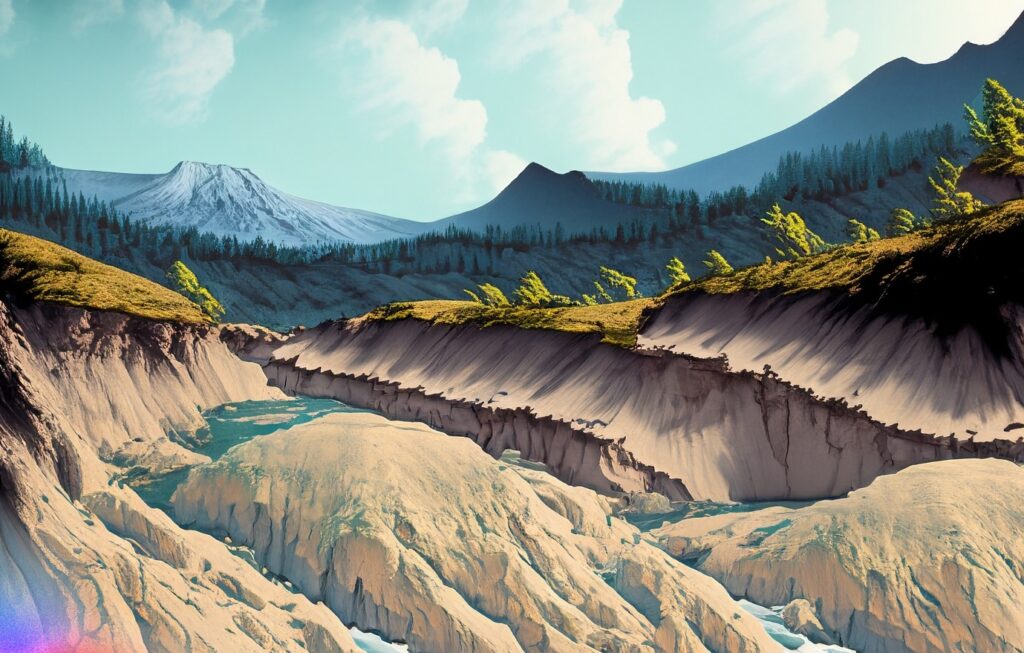Geomorphic Cycles and Landscape Development is a concept within the field of geomorphology, which is the study of the Earth’s surface features and the processes that shape them over time. These concepts are used to explain how landscapes evolve and change through a series of interconnected processes and cycles.

Table of Contents
What are Geomorphic Cycles?
Geomorphic cycles are the repetitive patterns of landscape evolution driven by various geological, climatic, and tectonic factors. These cycles involve a series of processes that shape the landforms of a region over long periods of time. The key components of geomorphic cycles include erosion, transportation, deposition, weathering, and tectonic activity. These processes interact with each other and operate at different spatial and temporal scales to shape the Earth’s surface.
"The Davis Cycle of Erosion is the geomorphic theory that explains the process of landform evolution. This theory was developed by William Morris Davis in the late 19th century and is considered one of the most significant contributions to the field of geomorphology."
Pillars of Geomorphic Cycle?
Denudation
Denudation refers to the overall lowering of the Earth’s surface through processes such as erosion, weathering, and mass wasting. These processes remove material from the Earth’s surface and contribute to the shaping of landscapes over time.
Uplift and Subsidence
Geological forces such as tectonic uplift and subsidence play a significant role in geomorphic cycles by altering the elevation and relief of landscapes. Uplift exposes rocks to weathering and erosion, while subsidence can lead to the accumulation of sediments and the formation of new landforms.
Climatic Variability
Climate influences geomorphic cycles through factors such as temperature, precipitation, and vegetation cover. Climatic variations over long periods of time can impact erosion rates, soil development, and the distribution of landforms across landscapes.
Base Level Changes
Base level represents the lowest point to which a river or stream can erode its channel. Changes in base level, such as sea level fluctuations or the formation of lakes, influence erosion and sediment transport processes, leading to adjustments in river profiles and landscape features.
What is Landscape Development?
Landscape development is the long-term evolution of landforms and landscapes through geomorphic processes and interactions. It involves the formation, modification, and degradation of landforms over geological time scales. Landscape development is influenced by a combination of factors, including tectonic activity, climate, rock type, topography, and human activities.
Landform Evolution: Landforms evolve over time through processes such as erosion, weathering, sediment transport, and deposition. For example, mountains are gradually eroded by rivers, glaciers, and weathering processes, leading to the formation of valleys, slopes, and sedimentary basins.
Landform Classification: Geomorphologists classify landforms based on their origin, characteristics, and geomorphic processes involved in their formation. Common landforms include mountains, valleys, plateaus, plains, coastal features, and karst landscapes.
Human Impacts: Human activities, such as urbanization, deforestation, agriculture, and mining, can significantly alter landscape development processes. These activities can accelerate erosion rates, modify natural drainage patterns, and lead to land degradation and landscape changes.
Factors that Influence Landscape Development
A number of factors can influence the rate and direction of landscape development, including:
Climate: Climate can influence landscape development by affecting the processes of erosion and deposition. For example, areas with high rainfall are likely to experience higher rates of erosion than areas with low rainfall.
Tectonic activity: Tectonic activity, such as earthquakes and volcanic eruptions, can influence landscape development by causing uplift and subsidence. This can create new landforms and modify existing landforms.
Human activity: Human activity, such as deforestation, agriculture, and urbanization, can also influence landscape development. For example, deforestation can increase the rate of erosion and alter the pattern of sediment transportation.
Read: Davis Cycle of Erosion